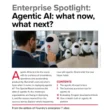Enterprises are facing significant hurdles in achieving effective monitoring across their increasingly complex hybrid environments. Recent research highlights challenges related to fragmented tools, maturity gaps, and cultural issues as organizations aim to shift their observability from reactive firefighting to proactive intelligence, with AI playing a key role.
A report from New Relic, titled 2025 Observability Forecast, shows the financial ramifications of service outages due to the lack of effective monitoring tools. It surveyed 1,700 IT and engineering leaders and found that a high-impact outage can cost a business around $2 million per hour. Surprisingly, organizations with full-stack observability reduced this cost to $1 million, yet nearly three-quarters do not achieve such visibility. The report further noted that 75% of organizations experienced a positive return on investment (ROI) from observability efforts, with some seeing returns of three to ten times their investment.
In parallel, a study from Enterprise Management Associates (EMA) found that 46% of respondents felt they successfully used their network observability tools, indicating a need for improvement. Many organizations reported several complaints regarding their observability tools, including limited scope, high costs, and insufficient customization.
The fragmentation of tools across organizations is a common theme highlighted in both reports. Organizations currently average 4.4 observability tools, which only complicates tracking and monitoring. Over half of the surveyed participants plan to consolidate onto unified observability platforms to streamline their processes. The EMA report echoes this sentiment, noting that 87% of network operations teams use multiple tools that do not integrate well with one another, leading to cumbersome "swivel-chair" troubleshooting.
To advance their maturity in observability, organizations must focus on integrating tools and automating workflows. EMA’s maturity model outlines five levels of observability: Ad Hoc/Reactive, Fragmented/Opportunistic, Integrated/Centrally Managed, Intelligent/Automated, and Optimized/AI-Driven. Most organizations currently find themselves in the middle stages, with fewer than half achieving success with their tools.
On a positive note, AI adoption for monitoring has seen growth, increasing from 42% in 2024 to 54% in 2025. The use cases for AI include assisted troubleshooting and automated root cause analysis, which help organizations move toward AI-driven observability. EMA’s model suggests that advanced users of AI can automate responses and predictions to streamline network management.
Both studies eventually underline that the journey to achieving mature observability requires more than just technology; it necessitates alignment across various teams, including DevOps, NetOps, and SecOps. As organizations streamline their observability efforts with unified, AI-enabled tools and cultural shifts, they can anticipate reduced downtime and increased operational efficiency.











